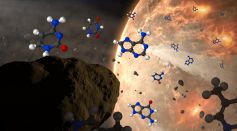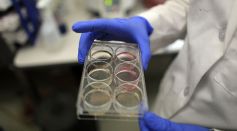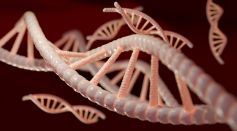Tags: Dna

Ancient DNA from Uruguay Gives a Glimpse of South America's 'Lost' Indigenous People

Meta-Analysis of Diverse Populations Reveals How Genes Affect People With Type 2 Diabetes

Experts Complete DNA and RNA Nucleobases from Meteorites, Supports Origin of Life from Space

Deciphering RNA 3D Structure Now Possible with Novel Technique

Importance of Antioxidants and Supplements Against Oxidative Stress Explained

Origin of Life on Earth: What Do DNA, RNA, and Chemical Reactions in Asteroids Have to Do With It?

Blue-Eyed People Share One Ancestor That Developed the Mutation 6,000 to 10,000 Years Ago
Highest Resolution Achieved Through 3D Imaging Tool Using Nanomaterials

Blood Biomarkers Linked to a Range of Mental Health Disorders

Earliest European Farmers Are 1.5 Inches Shorter Than Agriculture People of Recent Ages

Two New Species of Endangered Glass Frogs With See-Through Bodies Discovered in Active Mining Sites in Ecuador

Scientists Plan to Resurrect Extinct Christmas Island Rat; But Could De-Extinct Technology Save Endangered Animals?

Scientists to Resurrect the Lost Species of Tasmanian Tiger, Extinct Marsupials Will Bring Balance Back in Tasmania's Ecosystem

Learning and Memory: New Study Shows the Role of FMRP Protein in How to Memorize Things, Events, and Activities

Protein That Organizes DNA Also Responsible for the Healthy Functioning of Blood Stem Cells, Study Shows

A New Proteomics Method Links Excess R-loops to DNA Double-Strand Breaks and Genomic Instability

Intergeneration Trauma: Pregnant Tutsi Women During Rwanda Genocide Experienced Chemical Modifications Linked To Mental Disorder, Inherited By Children

Genomes of Roadside Weed Arabidopsis Thaliana Helps Scientist Understand Genetic Mutation

World's Tiniest Antenna Created to Monitor Motions of Proteins Using DNA

DNA Through Air: Scientists Propose New Way of Tracking Endangered Animals in the Wild
Most Popular

Can We Bring Back Extinct Animals? How De-Extinction Science and Technology Work

Why Do Stars Explode? Supernova Formation and the Final Stage of a Star Lifecycle

The Air Pollution Climate Link: What Environmental Science Reveals About Our Changing Planet

Extreme Heatwaves Explained: What Extreme Heat Science Reveals About Our Changing Climate





